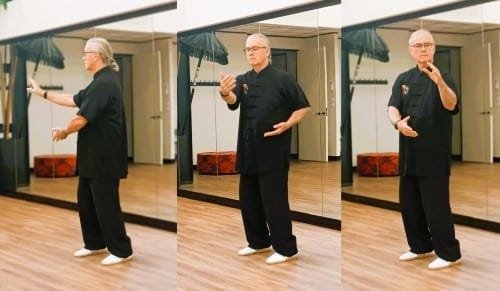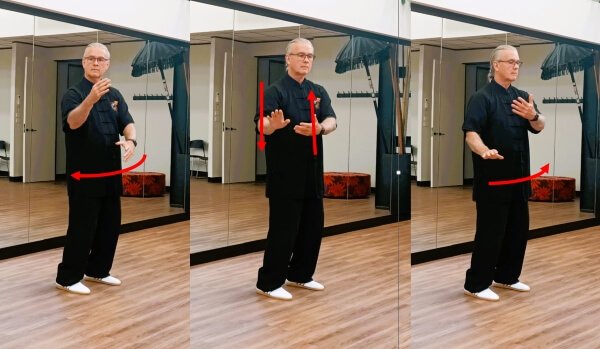
From the last push the mountain movement with the left hand turned over one finger at a time, the arm and hand are left extended with the waist to the right. The right hand resting on the side of the pelvis is moved outward slightly from the body. From this point, with the knees still bent, the waist is now turned to the left with the arms simply ‘tracking’ – as seen in the image above. This is the classic cloud hands as seen in Taijiquan.
Once the waist is turned as far as it goes the upper hand is turned palm down and the hands swap positions. The right hand is now the upper hand, palm facing you, and the left hand which is at dantian height is now palm downward. The waist is now turned to the right( see the image below ), again with arms/hands simply tracking with the waist. Once the extent of rotation of the waist is reached both hands are turned, the right palm down and the left palm up, and the hands swap positions. In Taijiquan, this is performing the classic arm break. Again, once the hands are swapped, the waist is turned back to the left, and the process is repeated another four times, six in total. This movement finishes with the hands/arms on the right side of the body ready to progress into the next movement.

Once you are familiar with the movement, the turning over of the hands can slowly be initiated once they have passed through the centreline of the body and finish at the point the arm break is done. That is, you commence the rotation of the palms at the center line and complete them at the waist endpoint. The lower palm should also be slightly angled back toward the lower dantian as it passes by(as seen in the first segment of the image above).
If you are having trouble effectively rotating the waist or a lot of restriction in the lumbar spine it may be useful to do the following: Sit upright and toward the front of a wooden chair, cross your arms across your chest, and practice turning your waist from side to side. Doing this locks your hips forward and gives a real sense of activating the waist. With time this will help with lumbar restriction and strengthen the muscles of the waist.
Corrections
When performing this movement keep the shoulders, arms, and hands relaxed.
Your hips should remain facing forward, keeping the knees bent should help maintain this forward position. The waist only should rotate.
Don’t rise, knees stay bent during the movement. Ensure your knees align with your feet and that the knees do not go beyond the vertical with your toes.
This entire movement should be performed in a gentle, relaxed, and flowing manner. The gaze should be relaxed, the eyes unfocused.
Benefits of this movement
Because the knees are kept bent through the entirety of this movement, the hips maintain their forward position, which means the waist is activated. The waist is the ‘driver’ of the movement.
This means that all the meridians that pass through the waist are influenced. This stimulates the flow of Qi in these meridians helping to remove stagnation.
This helps digestion, improves conditions related to the nervous system, and increases energy. Calms the mind &
relaxes the body through soft movement.
The coordination of the muscles associated with the action of moving the waist is improved and helps to mobilize the lumbar spine. The quads in the upper legs are also strengthened
Yours in Qigong
Sifu Peter